Lyophilized aqueous extracts of Mori Fructus and Mori Ramulus protect Mesenchymal stem cells from •OH-treated damage: bioassay and antioxidant mechanism
- PMID: 28464859
- PMCID: PMC5414230
- DOI: 10.1186/s12906-017-1730-3
Lyophilized aqueous extracts of Mori Fructus and Mori Ramulus protect Mesenchymal stem cells from •OH-treated damage: bioassay and antioxidant mechanism
Abstract
Background: Mori Fructus and Mori Ramulus are two traditional Chinese herbal medicines from mulberries. The present work explores their beneficial effects on •OH-treated mesenchymal stem cells (MSCs) and discusses possible mechanisms.
Methods: Lyophilized aqueous extracts of Mori Fructus (LAMF) and Mori Ramulus (LAMR) were prepared and analyzed using HPLC. LAMF and LAMR (along with morin) were further investigated for their effects on •OH-treated MSCs using the 3-(4,5-dimethylthiazol-2-yl)-2,5-diphenyl (MTT) assay. The direct antioxidation mechanisms were studied using 2-phenyl-4,4,5,5-tetramethylimidazoline-1-oxyl-3-oxide (PTIO•)-scavenging, 2,2'-azino-bis (3-ethylbenzo-thiazoline-6-sulfonic acid (ABTS+•)-scavenging and 1,1-diphenyl-2-picryl-hydrazl (DPPH•)-scavenging, as well as Cu2+-reducing and Fe3+-reducing antioxidant power. Finally, the indirect antioxidant mechanism was investigated based on the UV-vis spectra of Fe2+-chelation.
Results: In each LAMF and LAMR, seven phytophenols were successfully measured by HPLC, including five flavonoids (morin, rutin, astragalin, isoquercitrin and luteolin) and two non-flavonoids (chlorogenic acid and maclurin). MTT assays revealed that LAMF, LAMR and morin could effectively increase the survival of •OH-treated MSCs at 10-100 μg/mL, and could effectively scavenge PTIO• (IC 50 6609.7 ± 756.6, 4286.9 ± 84.9 and 103.4 ± 0.9 μg/mL, respectively), DPPH• (IC 50 208.7 ± 3.0, 97.3 ± 3.1 and 8.2 ± 0.7 μg/mL, respectively) and ABTS+• (IC 50 73.5 ± 5.8, 34.4 ± 0.1 and 4.2 ± 0.2 μg/mL, respectively), and reduce Cu2+ (IC 50 212.5 ± 7.0, 123.2 ± 0.9 and 14.1 ± 0.04 μg/mL, respectively) & Fe3+ (IC 50 277.0 ± 3.1, 191.9 ± 5.2 and 5.0 ± 0.2 μg/mL, respectively). In the Fe2+-chelating assay, the five flavonoids produced much stronger shoulder-peaks than the two non-flavonoids within 420-850 nm.
Conclusion: Mori Fructus and Mori Ramulus, can protect MSCs from •OH-induced damage. Such beneficial effects can mainly be attributed to the antioxidant action of phytophenols, which occurs via direct (ROS-scavenging) and indirect mechanism (Fe2+-chelating). The ROS-scavenging mechanism, however, include at least a H+-transfer and an electron-transfer (ET), and possibly includes a hydrogen-atom-transfer (HAT). In the Fe2+-chelating, flavonoids are more effective than non-flavonoids. This can be attributed to several adjacent planar chelating-sites between the 3-OH and 4-C = O, between the 4-C = O and 5-OH, or between the 3'-OH and 4'-OH in flavonoids. Such multiple-Fe2+-chelating reactions cause overlap in the UV-vis absorptions to deepen the complex color, enhance the peak strength, and form shoulder-peaks. By comparison, two non-flavonoids with catechol moiety produce only a weak single peak.
Keywords: Antioxidant; Electron transfer; Fe-chelating; Flavonoids; H+-transfer; Herbal medicine; Mesenchymal stem cells; Mori Fructus; Mori Ramulus.
Figures
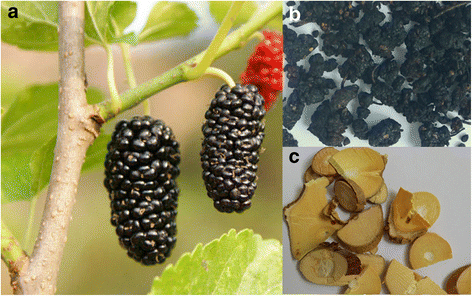


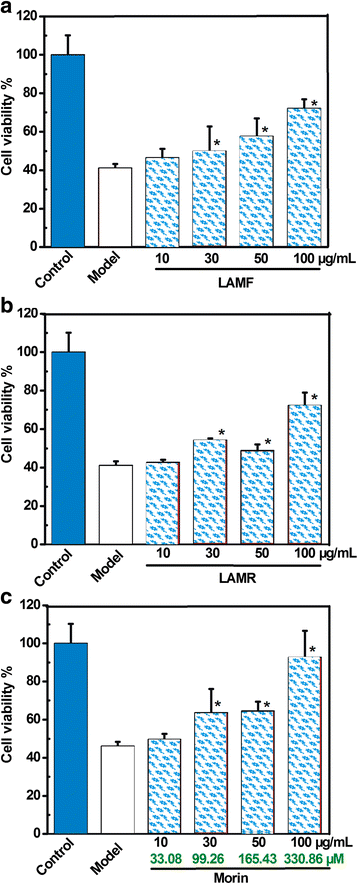
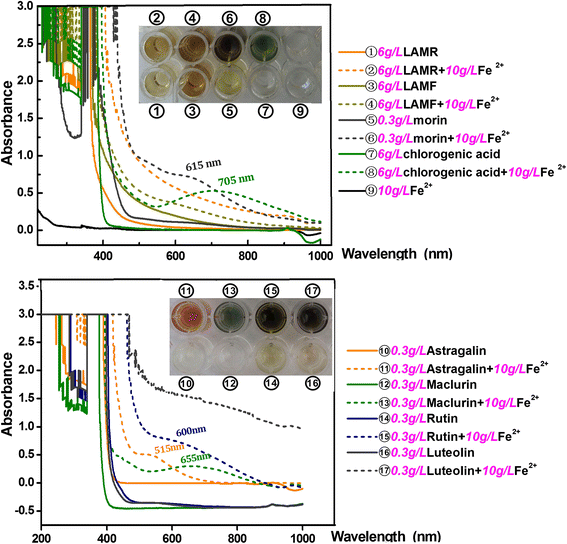
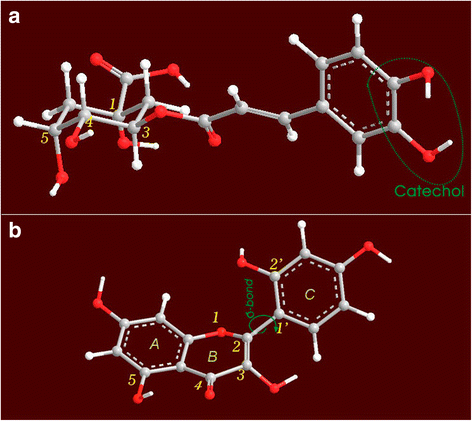
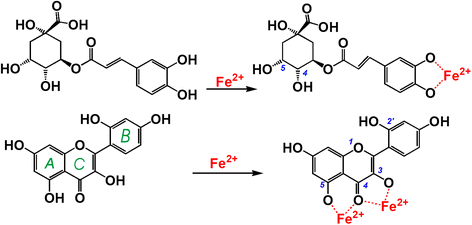
Similar articles
-
Sarcandra glabra (Caoshanhu) protects mesenchymal stem cells from oxidative stress: a bioevaluation and mechanistic chemistry.BMC Complement Altern Med. 2016 Oct 28;16(1):423. doi: 10.1186/s12906-016-1383-7. BMC Complement Altern Med. 2016. PMID: 27793132 Free PMC article.
-
Maclurin protects against hydroxyl radical-induced damages to mesenchymal stem cells: antioxidant evaluation and mechanistic insight.Chem Biol Interact. 2014 Aug 5;219:221-8. doi: 10.1016/j.cbi.2014.06.014. Epub 2014 Jun 25. Chem Biol Interact. 2014. PMID: 24973644
-
The mechanism of (+) taxifolin's protective antioxidant effect for •OH-treated bone marrow-derived mesenchymal stem cells.Cell Mol Biol Lett. 2017 Dec 27;22:31. doi: 10.1186/s11658-017-0066-9. eCollection 2017. Cell Mol Biol Lett. 2017. PMID: 29299033 Free PMC article.
-
Structures, bioactivities and future prospective of polysaccharides from Morus alba (white mulberry): A review.Food Chem. 2018 Apr 15;245:899-910. doi: 10.1016/j.foodchem.2017.11.084. Epub 2017 Nov 23. Food Chem. 2018. PMID: 29287458 Review.
-
Antioxidant activity of food constituents: an overview.Arch Toxicol. 2012 Mar;86(3):345-91. doi: 10.1007/s00204-011-0774-2. Epub 2011 Nov 20. Arch Toxicol. 2012. PMID: 22102161 Review.
Cited by
-
Antioxidant and Cytoprotective Effects of Tibetan Tea and Its Phenolic Components.Molecules. 2018 Jan 24;23(2):179. doi: 10.3390/molecules23020179. Molecules. 2018. PMID: 29364183 Free PMC article.
-
Widely Targeted Metabolomics Analysis to Reveal Metabolite of Morus alba L. in Different Medicinal Parts.Molecules. 2024 Aug 23;29(17):3981. doi: 10.3390/molecules29173981. Molecules. 2024. PMID: 39274829 Free PMC article.
-
Antioxidant Mechanisms of Echinatin and Licochalcone A.Molecules. 2018 Dec 20;24(1):3. doi: 10.3390/molecules24010003. Molecules. 2018. PMID: 30577443 Free PMC article.
-
π-π Conjugation Enhances Oligostilbene's Antioxidant Capacity: Evidence from α-Viniferin and Caraphenol A.Molecules. 2018 Mar 19;23(3):694. doi: 10.3390/molecules23030694. Molecules. 2018. PMID: 29562698 Free PMC article.
-
Simultaneous Qualitative and Quantitative Analyses of 41 Constituents in Uvaria macrophylla Leaves Screen Antioxidant Quality-Markers Using Database-Affinity Ultra-High-Performance Liquid Chromatography with Quadrupole Orbitrap Tandem Mass Spectrometry.Molecules. 2024 Oct 15;29(20):4886. doi: 10.3390/molecules29204886. Molecules. 2024. PMID: 39459254 Free PMC article.
References
-
- Fang YZ, Zheng RL. Theory and application of free radical biology. 2. Beijing: Science Press; 2002.
-
- Cihai Editorial Committee: Cihai (Illustrated edition, 6th ed). Shanghai: Shanghai Lexicographical Publishing House; 2009, p.1943.
-
- Su J, et al. Materia medica of the tang dynasty. Beijing: People’s Medical Publishing House; 1955.
MeSH terms
Substances
LinkOut - more resources
Full Text Sources
Other Literature Sources
Medical
Miscellaneous

